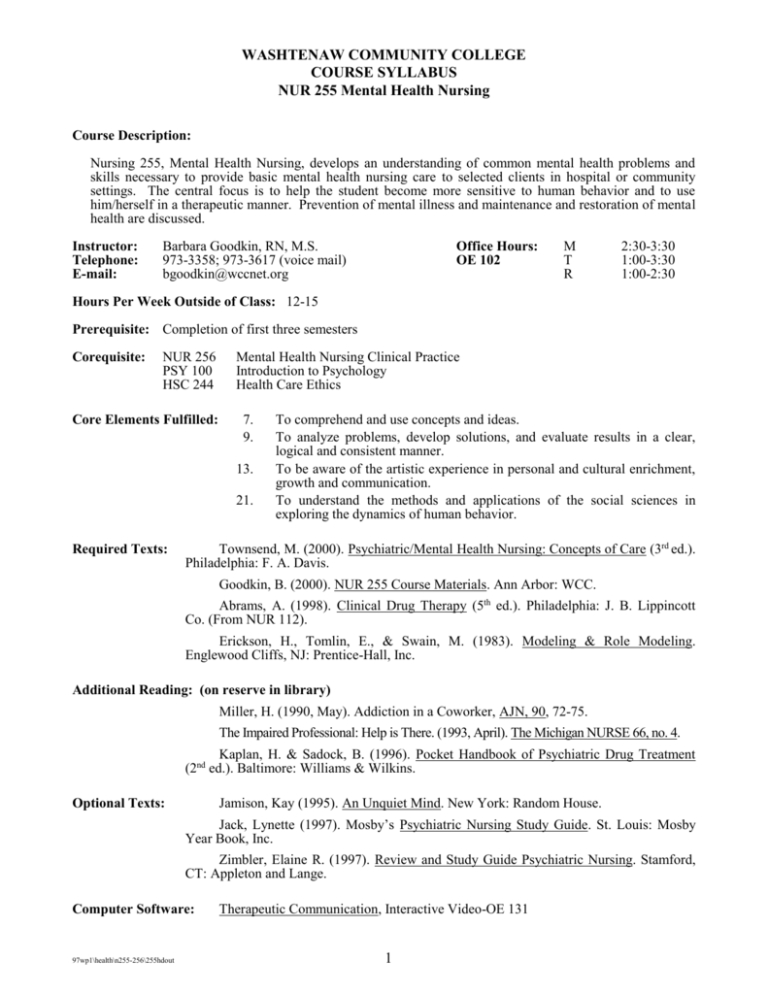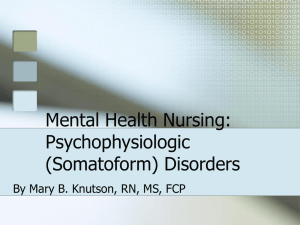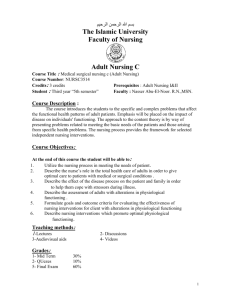Course Syllabus - courses.wccnet.org
advertisement

WASHTENAW COMMUNITY COLLEGE COURSE SYLLABUS NUR 255 Mental Health Nursing Course Description: Nursing 255, Mental Health Nursing, develops an understanding of common mental health problems and skills necessary to provide basic mental health nursing care to selected clients in hospital or community settings. The central focus is to help the student become more sensitive to human behavior and to use him/herself in a therapeutic manner. Prevention of mental illness and maintenance and restoration of mental health are discussed. Instructor: Telephone: E-mail: Barbara Goodkin, RN, M.S. 973-3358; 973-3617 (voice mail) bgoodkin@wccnet.org Office Hours: OE 102 M T R 2:30-3:30 1:00-3:30 1:00-2:30 Hours Per Week Outside of Class: 12-15 Prerequisite: Completion of first three semesters Corequisite: NUR 256 PSY 100 HSC 244 Core Elements Fulfilled: Mental Health Nursing Clinical Practice Introduction to Psychology Health Care Ethics 7. 9. 13. 21. Required Texts: To comprehend and use concepts and ideas. To analyze problems, develop solutions, and evaluate results in a clear, logical and consistent manner. To be aware of the artistic experience in personal and cultural enrichment, growth and communication. To understand the methods and applications of the social sciences in exploring the dynamics of human behavior. Townsend, M. (2000). Psychiatric/Mental Health Nursing: Concepts of Care (3rd ed.). Philadelphia: F. A. Davis. Goodkin, B. (2000). NUR 255 Course Materials. Ann Arbor: WCC. Abrams, A. (1998). Clinical Drug Therapy (5th ed.). Philadelphia: J. B. Lippincott Co. (From NUR 112). Erickson, H., Tomlin, E., & Swain, M. (1983). Modeling & Role Modeling. Englewood Cliffs, NJ: Prentice-Hall, Inc. Additional Reading: (on reserve in library) Miller, H. (1990, May). Addiction in a Coworker, AJN, 90, 72-75. The Impaired Professional: Help is There. (1993, April). The Michigan NURSE 66, no. 4. Kaplan, H. & Sadock, B. (1996). Pocket Handbook of Psychiatric Drug Treatment (2nd ed.). Baltimore: Williams & Wilkins. Optional Texts: Jamison, Kay (1995). An Unquiet Mind. New York: Random House. Jack, Lynette (1997). Mosby’s Psychiatric Nursing Study Guide. St. Louis: Mosby Year Book, Inc. Zimbler, Elaine R. (1997). Review and Study Guide Psychiatric Nursing. Stamford, CT: Appleton and Lange. Computer Software: 97wp1\health\n255-256\255hdout Therapeutic Communication, Interactive Video-OE 131 1 Audio Visuals: Psychopathologies, Concept Media Depression, Concept Media Communication Skills, Concept Media Schizophrenia, Concept Media Anxiety Disorders, Films for Humanities & Sciences Psychiatric Nursing Video Series, Mosby Reference Materials: Diagnostic & Statistical Manual IV APA Current Nursing journals Articles from instructor files The Harvard Mental Health Letter Overall Course Objectives: Upon completion of this course, the student will: I. Incorporate knowledge of nutrition, growth and development, pathophysiology and previous nursing courses into understanding the care and management of clients/patients/consumers in hospital and community settings with the following disturbed coping patterns: A. B. C. D. E. F. G. H. I. J. K. L. M. II. psychophysiologic factors affecting medical condition mood disorders anxiety disorders somatoform disorders dissociative disorders sexual and gender identity disorders personality disorders psychosis substance use disorders eating disorders factitious disorders sleep disorders impulse control disorder Apply Modeling and Role-Modeling theory throughout the nursing process in identifying and planning for the needs of clients/patients. A. Discuss pertinent areas of assessment related to disturbed coping patterns 1. Identify pertinent subjective data from the health history 2. Identify pertinent objective data from the nursing assessment 3. Identify pertinent diagnostic tests B. Discuss likely nursing diagnoses in order of priority for clients/patients/consumers experiencing disturbed coping patterns by selecting previously learned and new NANDA diagnostic categories from: 1. Previous Nursing courses NUR 102/103 NUR 123/124 NUR 131/132 97wp1\health\n255-256\255hdout 2 2. NEW a. b. c. d. e. f. g. h. i. j. k. l. m. n. o. C. anxiety disturbance in self-concept altered thought processes impaired verbal communication impaired social interaction social isolation risk for violence ineffective individual coping 1) defensive coping 2) ineffective denial altered sexuality patterns post traumatic response sensory perceptual alteration decisional conflict hopelessness altered role performance risk for self harm Recognize the impact of current medical management on nursing management in the areas of: 1. psychotropic medications 2. therapies III. Discuss the nurse’s responsibility for application of the Mental Health Code regarding: A. legal definition of mental illness B. persons requiring hospitalization C. recipient rights and responsibilities IV. Discuss the nurse’s responsibility related to substance abuse and drug diversion among nurses. Teaching Strategies: Lecture, case studies, discussion, group exercises and presentations, audio visual media and computeraided instruction. Course Grade: The final grade will be based on the following: Unit exams (4) Presentation 90% 10% 100% EXAM Average must be 78% in order to pass the course. Other Requirements: The student is expected to read the assignments and answer the performance objectives before each class session. Class time will be used to clarify and amplify student understanding. The student must attend a minimum of 70% of the class sessions to pass the course. Absences of more than 30% will result in a grade of F. Services for students with a documented disability are offered through the office of Learning Support Services (LSS). If you feel you are eligible for assistance in the classroom setting, contact Learning Support Services at (734) 973-3342 or stop by LA 104. To better serve you, please contact LSS as soon as possible prior to the first day of class. 97wp1\health\n255-256\255hdout 3 NUR 255 SECTION ASSIGNMENTS SESSION 1 2 3 4 5 TOPIC Introduction, History Legal considerations ASSIGNMENT Ch. 1 Ch. 40 course materials pp. A15-A22 course materials pp. A13-A14, Ch. 15 Ch. 4 Ch. 5, 7, course materials pp. A91-A95 Ch. 6, course materials pp. B37-B49 Ch. 2, pp. 14-17, Ch. 14 Ch. 3, course materials pp. A25-A39, A97-A101 Ch. 2, pp. 17-29 course materials pp. A109-A133 Unit I objectives Ch. 33 Ch. 25, course materials pp. A103-108 Physical Management Concepts of Psychobiology Role of the Nurse Therapeutic Communication Mental Health & Mental Illness Personality Development Anxiety & Defenses 6 7 8 9 10 EXAM #1 (Testing Center) Psychophysiologic Disorders Psychosis Psychosis (cont.) Anxiety Disorders EXAM #2 (Testing Center) Mood Disorders 11 12 Eating Disorders Personality Disorders The Impaired Professional 13 14 Substance Abuse Somatoform, Dissociative, Sexual Disorders EXAM #3 (Testing Center) Community Mental Health Crisis Intervention 15 16 17 18 19 20 21 Milieu Therapy Group Therapy Relaxation Therapy, Complementary Therapies ECT Psychopharmacology review Child & Adolescent Treatment Family Therapy Behavior Modification Review for Final Exam FINAL EXAM (Testing Center ) 97wp1\health\n255-256\255hdout 4 Ch. 27 Unit II A, B 1-8, 9a & c objectives Ch. 26, course materials pp. A71-A78, A139-144 Ch. 31 Ch. 32, Ch. 34 Articles in Library, Ch. 24 pp. 384-389 Video-Nurses: Web of Denial course materials pp. A89-A90 Ch. 24, course materials p. A87 Ch. 28, 29, 30 course materials pp. A135-A137 Unit II B 9-16 objectives Ch. 38 Ch. 11, 16, course materials pp. A79A83 Ch. 10 Ch. 8 Ch. 12, Ch. 21 Ch. 20 Ch. 19 Abrams, Ch. 8, 9, 10 course materials pp. A105-108 Ch. 22 Ch. 9 Ch. 17






